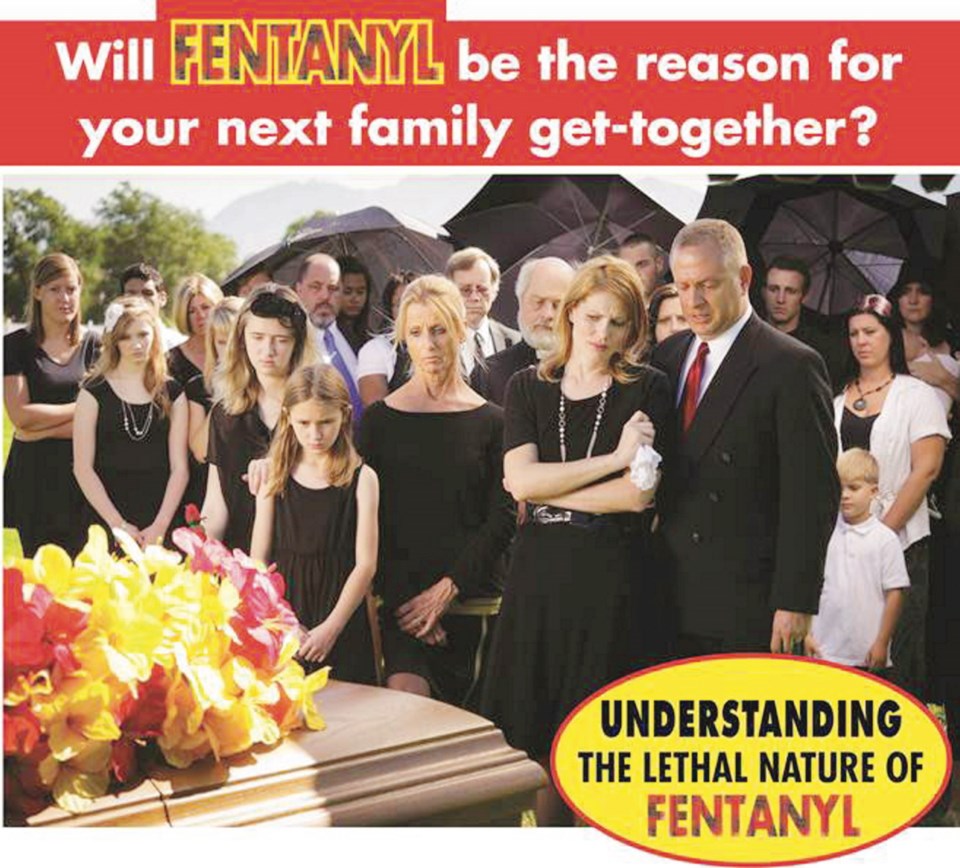A youth pastor who lost his 20-year-old son, a man who found his 21-year-old daughter dead in her bed and others who lost loved ones to overdoses where drug use was experimental or hidden.
These are some of the deaths that led a B.C. funeral services company to develop a hard-hitting public-awareness campaign about the dangers of deadly opioids, targeting everyone from young teens to adults.
“Yes, we’re in the funeral business. But it got to the point where enough is enough. We’re part of a lot of communities and we wanted to do something,” said Lawrence Little, founder of Alternatives Funeral and Cremation Services, which has a branch in Victoria.
“We’re not trying to reach the people on the Downtown Eastside, or on the street where there is outreach, but going to schools and churches to do our program,” said Little, noting coroners’ reports show the majority of recent overdose deaths have taken place in private residences and involved the powerful opioid fentanyl.
The province is on track to see about 1,500 overdose deaths this year, which would make it the worst year yet and represents a marked increased from 2016’s 981 deaths, which sparked a public-health emergency. There have been 175 overdose deaths on Vancouver Island so far this year — the equivalent of 5 1/1 busloads of people.
Little said funeral directors deal with multiple overdose deaths a month, some of which involve very young people.
In an event planned for the new year in the Lower Mainland, attendees will be greeted by a hearse, Little said. “The back door will be open with a casket and police tape. There will be a chalk outline of a body, a tipped-over pill bottle and a syringe,” he said. “You’re going to get the message that this is a serious program.”
The presentation will include speakers such as police officers, community coroners and victims’ services workers, “who go with the officers to ring the doorbell and tell people their son or daughter is dead.”
Little said he has had some pushback from educators who think the presentation might be upsetting, but he’s also been told that a more visceral, emotional experience is what will get young people paying attention and talking more about drugs and related risks.
“Shock value is the only way to get attention, sometimes. And it’s much better than reading off statistics,” he said, using the example of graphic drinking and driving campaigns. “Today, people are pretty aware of [the dangers of drinking and driving]. But you know what’s in a case of beer. If you’re using an opiate and are told it’s an oxy or T3, you don’t know if it’s been laced with fentanyl.”
Chris Benesch, the Victoria-area funeral director for the company, said he will see how the program goes in the Lower Mainland before planning a local event. He said he sees about two overdose deaths a month, but hears from larger funeral companies in the city that the problem is getting worse.
Charlotte Poncelet, executive director of the British Columbia Funeral Association, said funeral directors are caregivers and the spate of overdose deaths can be difficult for them, too.
“Many professionals in our business are dealing with families in grief. One grief is not worse than the other, but there is a different dimension to the disbelief, stigma and guilt with these [overdose] deaths,” Poncelet said.
She hasn’t heard of other funeral-service companies doing overdose-outreach programs but said advocacy is not uncommon. Her organization is looking at training funeral directors in communicating with families about addiction and drug use in non-judgmental ways.
Other funeral services on the Island, such as Royal Oak Burial Park, refer bereaved families to support groups such as Moms Stop the Harm and Grief Recovery After a Substance Passing.
Dr. Richard Stanwick, the Island’s chief medical officer, said it’s a sign of how broad the impact of the overdose crisis is when professionals such as funeral directors speak out for change. “Any community partners we can get in raising awareness is welcome.”
Stanwick is uncertain, however, whether graphic messaging has the greatest impact. “We’ve tried that and with shock value, science shows these messages can have a short-lived effect.”
Stanwick said Island Health has shifted to messages that promote safer drug use and help for those struggling with addiction.
Sharlene Law, executive director of Umbrella Society for Addictions and Mental Health, said any overdose-prevention campaign for youth should involve consulting them first. “Youth think very differently. Kids these days can be a bit de-sensitized to things,” said Law, who has teenagers of her own. She said promoting fear-based stereotypes about drug use runs the risk of preventing youth from speaking about the issues with their families.
